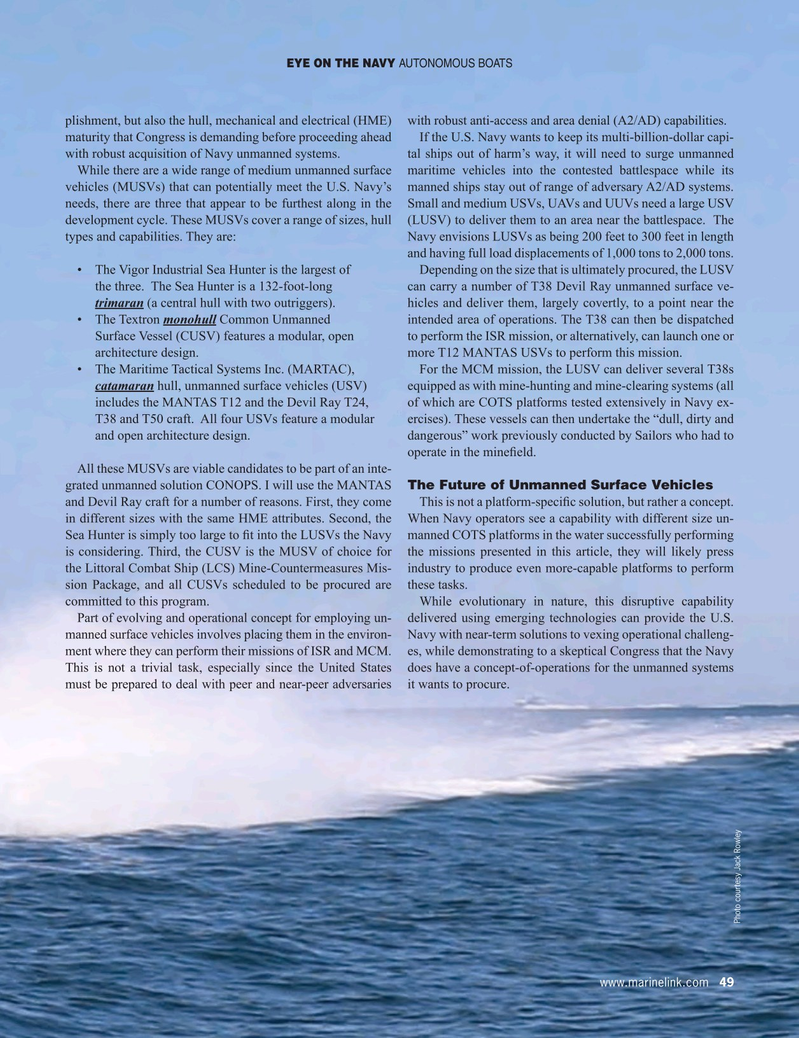
Page 49: of Maritime Reporter Magazine (November 2022)
The Workboat Edition
Read this page in Pdf, Flash or Html5 edition of November 2022 Maritime Reporter Magazine
EYE ON THE NAVY AUTONOMOUS BOATS plishment, but also the hull, mechanical and electrical (HME) with robust anti-access and area denial (A2/AD) capabilities. maturity that Congress is demanding before proceeding ahead If the U.S. Navy wants to keep its multi-billion-dollar capi- with robust acquisition of Navy unmanned systems. tal ships out of harm’s way, it will need to surge unmanned
While there are a wide range of medium unmanned surface maritime vehicles into the contested battlespace while its vehicles (MUSVs) that can potentially meet the U.S. Navy’s manned ships stay out of range of adversary A2/AD systems. needs, there are three that appear to be furthest along in the Small and medium USVs, UAVs and UUVs need a large USV development cycle. These MUSVs cover a range of sizes, hull (LUSV) to deliver them to an area near the battlespace. The types and capabilities. They are: Navy envisions LUSVs as being 200 feet to 300 feet in length and having full load displacements of 1,000 tons to 2,000 tons.
• The Vigor Industrial Sea Hunter is the largest of Depending on the size that is ultimately procured, the LUSV the three. The Sea Hunter is a 132-foot-long can carry a number of T38 Devil Ray unmanned surface ve- trimaran (a central hull with two outriggers). hicles and deliver them, largely covertly, to a point near the • The Textron monohull Common Unmanned intended area of operations. The T38 can then be dispatched Surface Vessel (CUSV) features a modular, open to perform the ISR mission, or alternatively, can launch one or architecture design. more T12 MANTAS USVs to perform this mission. • The Maritime Tactical Systems Inc. (MARTAC), For the MCM mission, the LUSV can deliver several T38s catamaran hull, unmanned surface vehicles (USV) equipped as with mine-hunting and mine-clearing systems (all includes the MANTAS T12 and the Devil Ray T24, of which are COTS platforms tested extensively in Navy ex- T38 and T50 craft. All four USVs feature a modular ercises). These vessels can then undertake the “dull, dirty and and open architecture design. dangerous” work previously conducted by Sailors who had to operate in the mine? eld.
All these MUSVs are viable candidates to be part of an inte- grated unmanned solution CONOPS. I will use the MANTAS The Future of Unmanned Surface Vehicles and Devil Ray craft for a number of reasons. First, they come This is not a platform-speci? c solution, but rather a concept. in different sizes with the same HME attributes. Second, the When Navy operators see a capability with different size un-
Sea Hunter is simply too large to ? t into the LUSVs the Navy manned COTS platforms in the water successfully performing is considering. Third, the CUSV is the MUSV of choice for the missions presented in this article, they will likely press the Littoral Combat Ship (LCS) Mine-Countermeasures Mis- industry to produce even more-capable platforms to perform sion Package, and all CUSVs scheduled to be procured are these tasks. committed to this program. While evolutionary in nature, this disruptive capability
Part of evolving and operational concept for employing un- delivered using emerging technologies can provide the U.S. manned surface vehicles involves placing them in the environ- Navy with near-term solutions to vexing operational challeng- ment where they can perform their missions of ISR and MCM. es, while demonstrating to a skeptical Congress that the Navy
This is not a trivial task, especially since the United States does have a concept-of-operations for the unmanned systems must be prepared to deal with peer and near-peer adversaries it wants to procure.
Photo courtesy Jack Rowley www.marinelink.com 49
MR #11 (34-49).indd 49 11/4/2022 11:56:13 AM

 48
48

 50
50
